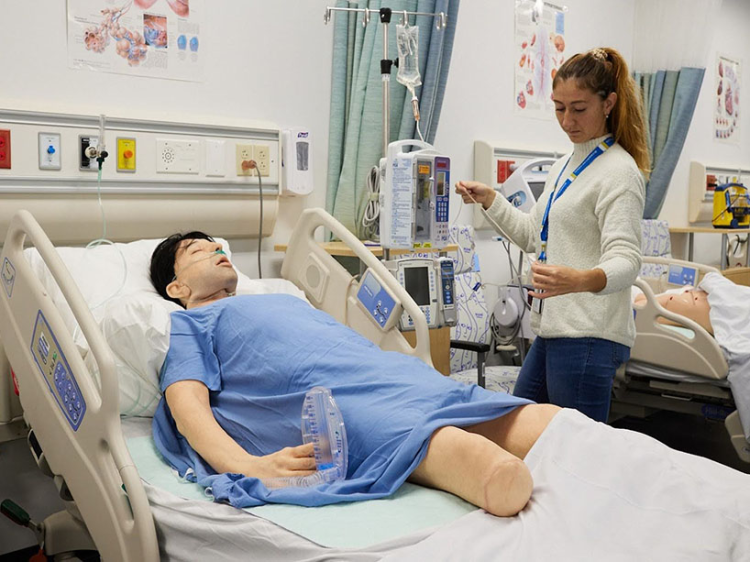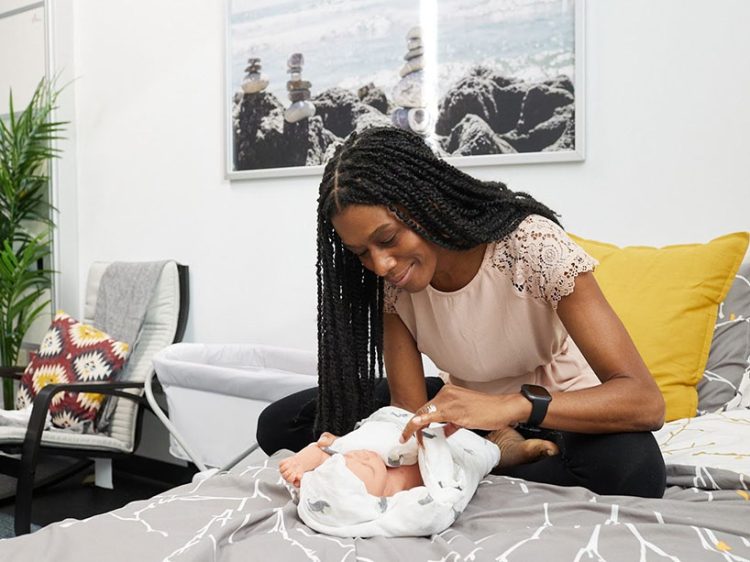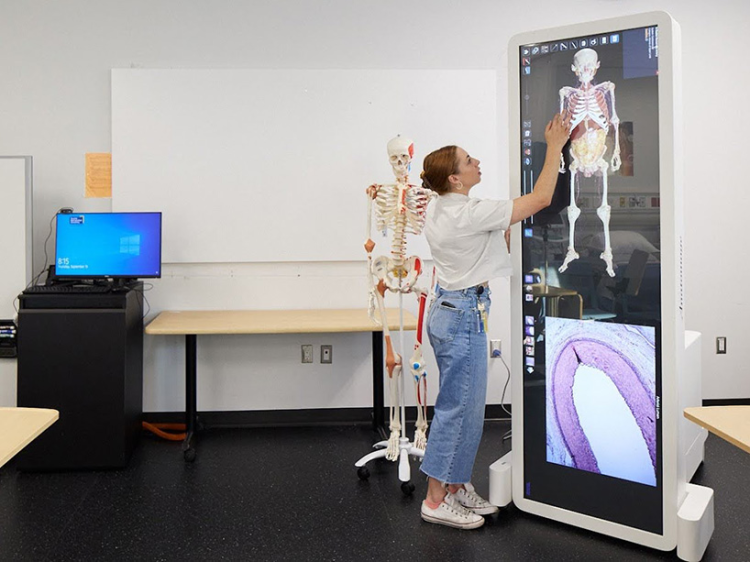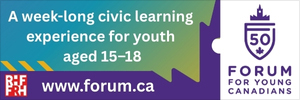They say the best way to learn is by doing.
That's the case for nursing students at Toronto Metropolitan University (TMU) who have access to interactive learning through all four years of their undergraduate degree, thanks to the nursing simulation lab and their hi-tech mannequins.

Professional practice and simulation coordinator Jessica Slutsker, RN, MN, with a low fidelity mannequin in the nursing simulation lab.
The lab is a safe learning space where students practise real medical scenarios and critical care skills. Students can treat burns, handle respiratory emergencies and monitor declining vital signs without worrying about making mistakes that could harm real patients.
TorontoMet Today spoke with professional practice and simulation coordinators Kylie Way and Raquel Lashley from the Daphne Cockwell School of Nursing (DCSN) to learn more.
How many mannequins does TMU have?
TMU's nursing program uses 15 different mannequins for training.
Seven are high-fidelity mannequins that can simulate complete vital signs, pulses, cardiac, bowel and lung sounds and even hold live conversations with students. Of these, there are three adult mannequins, including a birthing mannequin that can simulate hemorrhage, birth and complicated delivery. There are also two high-fidelity paediatric mannequins and two baby mannequins.
We also have eight low-fidelity, high-realism mannequins. They vary in ethnicity, sex, age and ability. These mannequins normalize the vast range of bodies students will care for throughout their nursing practice.
What medical issues do the mannequins simulate?
The high-fidelity mannequins can recreate sounds and physical signs of many medical conditions like pneumonia, cardiac arrhythmias and respiratory distress. We can change the mannequins' medical issues using special software.
The low-fidelity, high-realism mannequins show visual signs of various physical conditions including surgical incisions, cleft palates, burns, fat disposition reflective of older age, amputation, chest tube and gastric tube insertion sites and pressure ulcers.

Professional practice and simulation coordinator Raquel Lashley, RN, MN, in the Community Simulation suite with a high-fidelity infant mannequin.
What happens during mannequin simulations?
Students are given a patient case study to review beforehand. They then work through a 20-minute scenario, treating the mannequin as if it were a real patient in a hospital setting.
After each simulation, facilitators lead a discussion where students reflect on their decisions and process any emotions that came up.
What do students think about the simulations?
Student feedback has been overwhelmingly positive. Many ask for more simulation opportunities.
One second-year student said: "I thought that the ability to attempt managing critical care/clinical deterioration in a controlled setting where mistakes could be made without serious repercussions was especially beneficial in preparing for independent practice in the future."
Another student shared: "This simulation gave me the opportunity to experience a situation in a safe space to intervene, where even if I make a mistake it won't cause harm to anyone allowing me to perform better in a similar situation in future practices. The group discussion is also helpful to learn from my peers' insights and experiences. The back and forth conversations also makes me think deeper about the details."

Professional practice and simulation coordinator Kylie Way, CHSE, RN, MN, with the Anatomage Table.
What other tools are in the nursing simulation lab?
In addition to the mannequins, the simulation lab includes different medical equipment such as IV pumps, epidural devices, simulated oxygen and wall suction.
Students also have access to digitized cadavers via the Anatomage Table, complete with thousands of images and interactive features. The images help students learn anatomy and physiology while practicing skills.
How has experiential learning and nursing evolved at TMU?
Students always ask for more experiential learning opportunities and our program has grown significantly, especially since COVID-19.
When the pandemic forced universities to offer remote or hybrid learning, our team stepped in to develop virtual gaming simulations with nursing faculty. This helped maintain much-needed nursing education when it was needed most.
Our team developed this program thanks to the generous support of community donors and governmental support. Experiential learning activities are critical to student success they help build critical thinking, clinical competence and confidence, ultimately supporting a smoother transition into nursing practice and the development of stronger, more prepared nursing professionals. Support like that ensures the program continues to thrive and develop.













